200 years of St John’s Catholic Parish Campbelltown
August 23, 2022
St John’s Parish at Campbelltown is about to celebrate its 200th anniversary and the Board of Campbelltown Catholic Club offers its hearty congratulations. In this special article, The Catho’s Community Liaison (and local history buff) Jeff McGill paints a brief portraits of those two centuries.
The first Mass: 1 September 1822
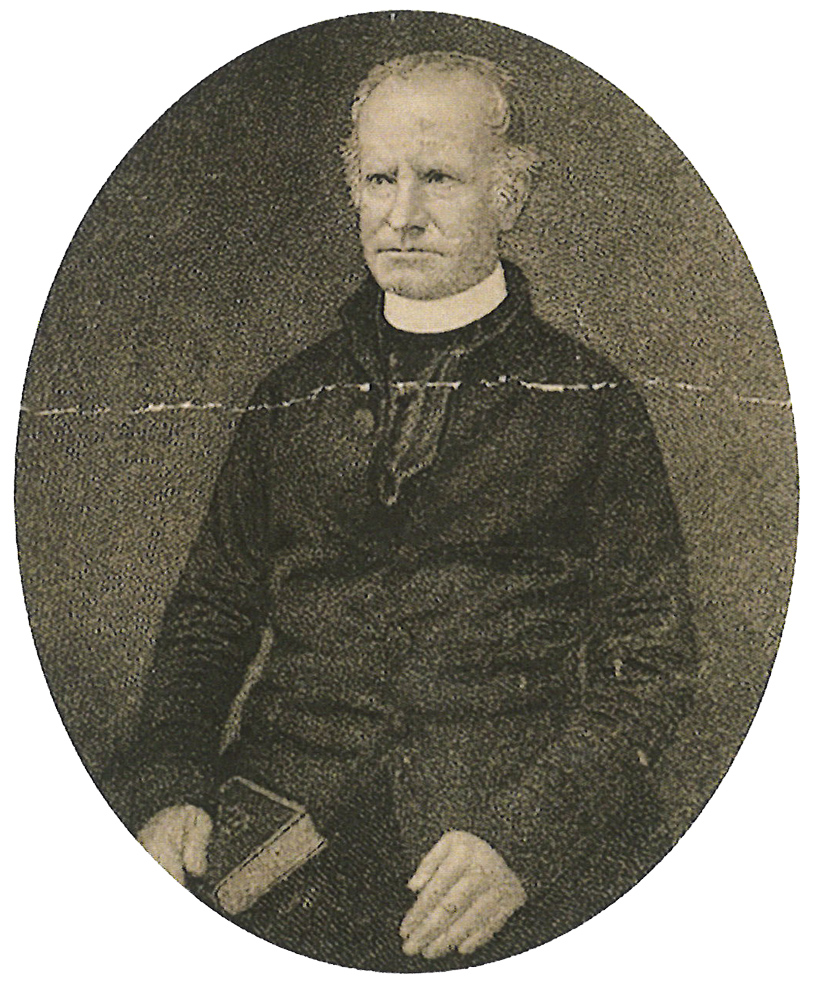
“Wintry, wet, and stormy” is how early Campbelltown historian J.P. McGuanne described the first day of spring in 1822. That was bad news for Father John Therry, who’d arrived in Campbelltown to celebrate its first Mass in the open air of the village green.
Merely a town in name, Campbelltown was just a few tiny bark huts. It was only six years after the infamous Appin Massacre of 1816 had wiped out Indigenous resistance, and four years before Fred Fisher would go missing (with reported sightings of his ghost) in 1826. Many of the small farmers were Irish Catholic ex-convicts, but they had no place of worship. So the spreading branches of gumtrees on the green — present-day Mawson Park — was all they had as a rain storm poured down on Father’s Therry’s words. So, the pioneer priest led his flock to the nearest building — the unfinished Anglican church. It was without a floor or windows, but it had a roof, so…in they went. That created the historic quirk that the first religious service held in St Peter’s Anglican Church was a Catholic Mass!
The Anglican rector, Thomas Reddall, was not happy about this trespass, or “desecration” by Father Therry but the unrepentant Irishman insisted his action had merely bestowed honour on St Peter’s: “I took the liberty in question, anticipating your consent, when my dilemma was explained.” The matter went no further…and an unlikely friendship might have even bloomed between the two Christian clergymen. Reddall would later make a donation towards Therry’s appeal for his church building fund.
The Australian Dictionary of Biography describes Therry as “articulate” Celt whose influence was as impressive among Protestants, as it was among Catholics. “He also early formed a lasting interest in the Aboriginals, who became very attached to him,” it added. Father Therry also had great sympathy for his countrymen in convict chains and was known to carry small change and tobacco to share with road gangs he passed.
The priest spent many hours on horseback. The Catholic Press on 1 May 1897 would feature the childhood memories of William Byrne, who noted: “Well do I remember my parents relating how Father Therry used to celebrate Mass at St Mary’s in the early morning, and then getting on his horse gallop to Campbelltown, a distance of 35 miles, to say Mass at my grandfather’s house, returning to Sydney the same day, perhaps visiting Liverpool and Parramatta on his way.”
The original St John’s
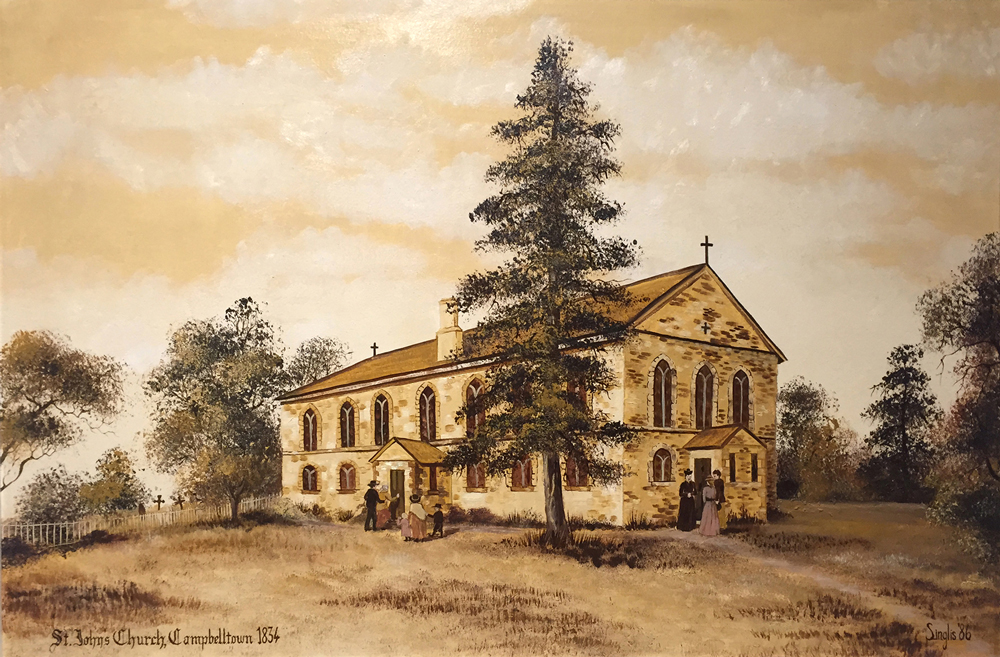
The Catholics of Campbelltown continued without a church for some years, Father Therry jumping out of his saddle to hold Mass in the green, or in a hut, or “in the Courthouse-room above the noise and stench of crowded criminal cells.” There was also no local burial ground either, the Catholic dead being buried in Anglican plots.
All that began to change when the son of a convict, James Burke (Bourke), made a donation. On 16 June 1825, Father Therry offered him publicthanks in the Sydney Gazette, “for his offer of five acres of cleared and valuable land” on the hilltop overlooking Campbelltown (at the corner of Broughton and George Streets). The foundation stone of a St John the Evangelist Church was laid on 12 December 1824, with William Bradbury supplying the material. Father Therry planned a grand structure, a many-windowed church capable of holding 400 people. The land was consecrated 27 December 1826.
But no real progress happened for years. There was little money to spare among the battling Irish families of Campbelltown, and Father Therry was half shepherd and half wolf as he pressured people for donations. “Were you ever stuck up yourself, Father?” came one reply.
A public meeting at Campbelltown’s Forbes Hotel in 1833 petitioned the Governor to match the funds raised by the community. He did. The subscription list of 1833 is a who’s who of our Cathol
ic pioneers, names such as Burke/Bourke, Byrne, Vardy, Hurley, Keighran, Bradbury, Scarr, Rose, Meehan, and Rudd. As the walls went up, Father Therry offered the first Mass at St John’s on 27 July 1834.
In the following year, Father Therry made Campbelltown his home as its first parish priest, residing in a rented “Chapel House” in Cordeaux Street.
The hilltop cemetery got it most famous burial in 1837 when James Ruse — Australia’s first farmer — died. His headstone noted he “sow’d the first grain”.
By 1838, St John’s Church had a roof and the rising building could be seen from the main street, but that same year Father Therry was sent by Archbishop Polding to Van Deimen’s Land (Tasmania).
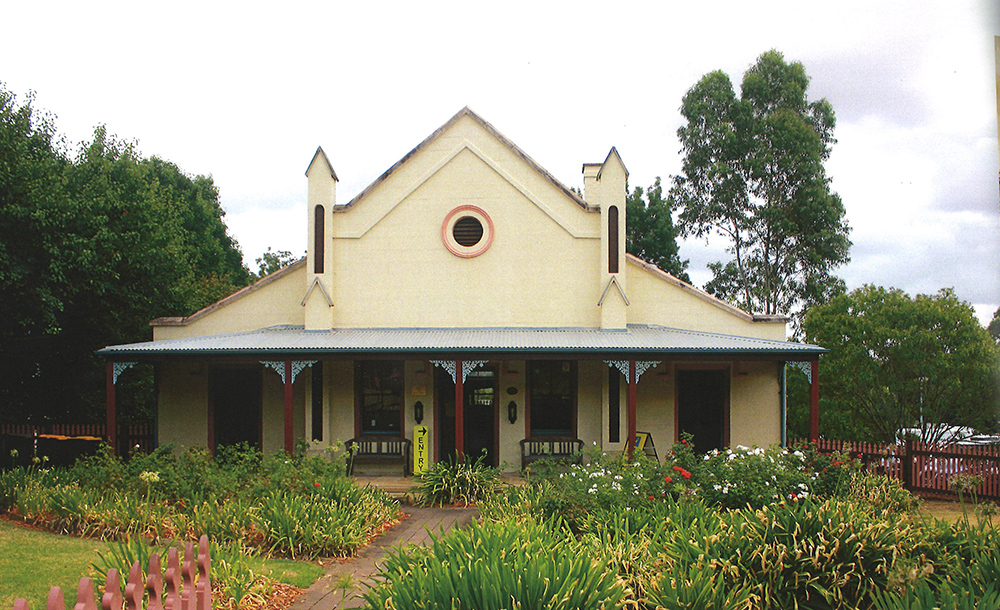
Campbelltown’s new parish priest was Father James Alipius Goold (also known as Gould), who saw the opening of the first proper Catholic schoolhouse in 1840. Erected on land donated by Bradbury’s daughter, Mary Sheil, its cornerstone was blessed on St Patrick’s Day, so it became known as St Patrick’s. That building still stands today, better known as Quondong (the Campbelltown Visitor Information Centre).
St John’s Church on the hilltop was finished shortly afterwards, a bold stone structure with two rows of windows, the larger over the smaller, which gave the idea of the church having two floors. (Father Therry had a great weakness for what he called “opes”— openings, without any consideration for the intense heat and glare of summer light.)
The Australian Chronicle reported that on 31 August 1841 the Church of St John the Evangelist was officially opened with a Solemn High Mass by Father Murphy, the Vicar-General of NSW. “The church is situated upon a beautiful eminence, commanding a view of the town and the surrounding district,” the newspaper reported.
Building a second St John’s
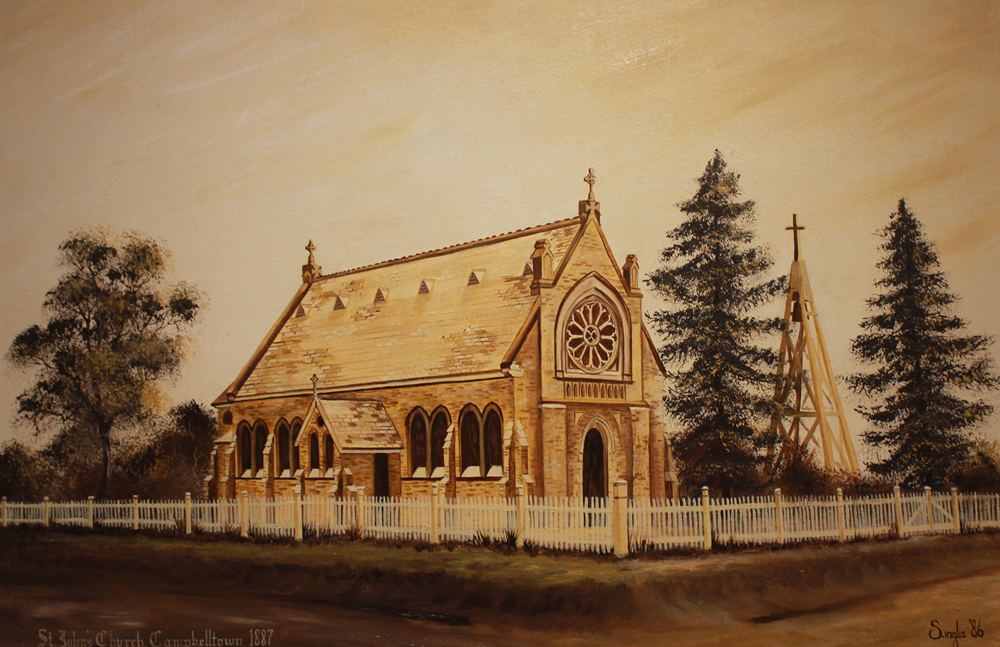
That commanding view, it must be noted, took a far bit of time and sweat for parishioners to reach without a horse or buggy. So Father Goold held many of his Masses at his presbytery in Cordeaux Street, a portion of which was fitted out as a worship hall. This policy was also adopted by his successors, Father John Paul Roche, Monsignor John Lynch and Father Augustus Petre. The hilltop church looked like an expensive white elephant.
Sydney Mail, 27 October 1883, noted that reality: “The presbytery or parsonage is situated at the foot of the hill…[and] apart from the exertion necessary to reach the church, there was little occasion to use the larger building. In referring to the selection of such an inconvenient position for a church, not only on the ground of inaccessibility, but also from its exposed character.” The idea of building a better-sited church, next to the presbytery, was obviously in play as early as the 1840s as the church began buying land along Cordeaux and Lindsay Streets.
When Father James Dunne arrived as the new parish priest in 1886 he bit the bullet and started work on a more practical building. In March 1886 he signed a contract for the erection of a new St John’s in Cordeaux Street for a sum of £1686. Its Gothic architecture was very different to the hilltop church, set off by an elaborate stained glass circular window framed in dressed stone above the main entrance. This new building was in use by December, but officially blessed and opened by Cardinal Moran on 22 May 1887.
Worshippers were sentimental about having to say goodbye to the old church off Broughton Street, but older folk “will gladly accept the boon of being able to worship without having to climb the steep hill,” the Campbelltown Herald noted.
Sisters and Brothers
“Old St John’s” was renamed St Patrick’s Convent in 1888 and handed to the Sisters of the Good Samaritan. The turned it into a Catholic secondary school for girls — St Patrick’s College — and it remained at that site until 1970 when it transferred to the Westview site on a nearby hilltop that had previously been St John’s Preparatory School for Boys. (Which explains why the road outside today’s St Patrick’s College is called St John’s Road).
The Sisters, in the 1880s, also took over St Patrick’s Primary School (Quondong) but it ceased to exist when a new St John the Evangelist Primary School opened off Lindesay Street, next to the church, in 1914.
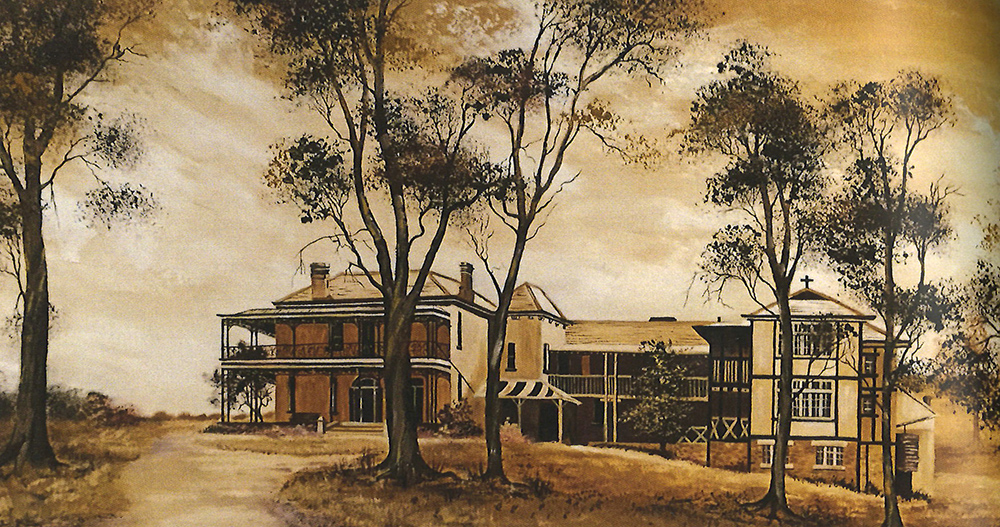
The Marist Brothers arrived in Campbelltown in 1926 and converted the old Badgally homestead into a secondary school for boys called St Gregory’s College. In the 1930s, the Rudd family estate off Narellan Road – Maryfields – was donated by Sarah Mary Keane to the Catholic Franciscan Fathers. A large brick novitiate was erected in 1955, with the Poor Clare Nuns arriving in the 1960s.
These religious orders became a vital part of the story of St John’s Parish.
A world moving on
Father Dunne, who erected the new St John’s in 1887, remained as the beloved parish priest of Campbelltown until his death in 1931. His successor, Father Arthur McHugh, remained until 1954. That was the year Campbelltown became part of the newly-created Wollongong Diocese.
It was during Father Tom Grant’s time as parish priest, in 1964, that a group of parents working as volunteer labourers and building classrooms at a cash-strapped St John’s Primary School came up with the idea of creating a local social club, with the profits helping to fund Catholic education.
Campbelltown Catholic Club duly opened its doors in 1968 and has since donated tens of millions of dollars to local schools and community groups.
As we look back on 200 years, most of the old landmarks in this story still exist. The green where Father Therry preached his first Mass (Mawson Park) still survives, as does nearby St Peter’s Church. The first Catholic Church on the hilltop has been restored, and the second Catholic Church dating to the 1880s is still a beating heart of parish life.
The generations of parishioners who have come and gone are not as immediately visible to us — dust to dust, ashes to ashes — but their spirit does lives on today. As the Bible notes, “Do you not know that you are God’s temple and that God’s Spirit dwells in you?” Architecture and historic dates are important, but it is the spirit, faith, families, community work and humanity of St John’s Parish that truly makes 200 years worth celebrating.
Pastors of St John’s
- 1833-1838 Fr John Joseph Therry PP
- 1838-1848 Fr James Alipius Gould PP
- 1850-1877 Fr John Paul Roche PP
- 1878-1883 Mgr John P. Lynch PP
- 1884-1885 Fr Augustus William Petre PP
- 1886-1933 Fr James Dunne PP
- 1933-1954 Fr Arthur McHugh PP
- 1954-1955 Fr Thomas Vaughan Adm.
- 1955-1957 Fr Isadore Ekerick Adm.
- 1957-1974 Fr Thomas Grant Adm.
- 1974-1978 Fr Peter L. Comensoli Adm.
- 1978-1985 Fr Paul Ryan PP
- 1985-1997 Fr Bryan Jones PP
- 1997-2017 Fr Michael Healy pp
- 2017-present Fr John Ho PP
Select Bibliography
- Catholic Press, 1 May 1897, 17 April 1919, 29 January 1925, 26 February, 1925, 12 November 1931.
- Freeman’s Journal, 10 April 1897.
- Sydney Gazette, 16 June 1825, 20 December 1826.
- Australian Chronicle, 2 September 1841.
- Sydney Mail, 27 October 1883.
- Campbelltown News, 23 July 1920.
- Australian Dictionary of Biography
- Pictorial History of Campbelltown & District, Jeff McGill, 2017. Campbelltown Catholic Club:The First Fifty Years, Jeff McGill, 2018.
- https://sjec.org.au/parish/campbelltown-parish/ “Our Parish History”.


